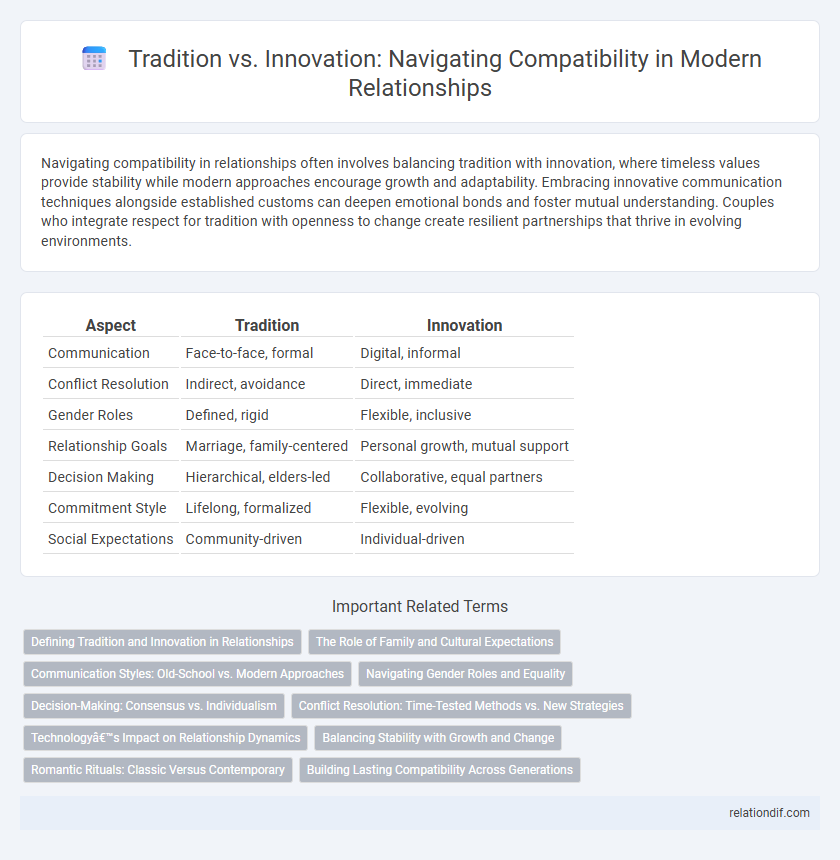Navigating compatibility in relationships often involves balancing tradition with innovation, where timeless values provide stability while modern approaches encourage growth and adaptability. Embracing innovative communication techniques alongside established customs can deepen emotional bonds and foster mutual understanding. Couples who integrate respect for tradition with openness to change create resilient partnerships that thrive in evolving environments.
Table of Comparison
| Aspect | Tradition | Innovation |
|---|---|---|
| Communication | Face-to-face, formal | Digital, informal |
| Conflict Resolution | Indirect, avoidance | Direct, immediate |
| Gender Roles | Defined, rigid | Flexible, inclusive |
| Relationship Goals | Marriage, family-centered | Personal growth, mutual support |
| Decision Making | Hierarchical, elders-led | Collaborative, equal partners |
| Commitment Style | Lifelong, formalized | Flexible, evolving |
| Social Expectations | Community-driven | Individual-driven |
Defining Tradition and Innovation in Relationships
Tradition in relationships emphasizes long-established customs, roles, and expectations that have been passed down through generations, fostering stability and predictability. Innovation in relationships embraces new ideas, communication styles, and non-traditional roles, encouraging adaptability and personal growth. Understanding how tradition and innovation influence relationship dynamics helps partners find balance and compatibility in evolving social contexts.
The Role of Family and Cultural Expectations
Family and cultural expectations profoundly influence relationship compatibility, often shaping partners' values and life goals. Traditional views emphasize collective harmony and adherence to familial roles, while innovative perspectives prioritize individual autonomy and evolving norms. Balancing these forces requires open communication and mutual respect to foster enduring connections that honor both heritage and personal growth.
Communication Styles: Old-School vs. Modern Approaches
Old-school communication in relationships emphasizes face-to-face conversations, handwritten notes, and verbal affirmations that build emotional intimacy through direct interaction. Modern approaches leverage digital tools like texting, video calls, and social media, allowing for instant connectivity and continuous engagement despite physical distance. Balancing these communication styles enhances compatibility by respecting traditional emotional expressions while embracing technology's convenience for real-time connection.
Navigating Gender Roles and Equality
Navigating gender roles and equality in relationships requires balancing traditional expectations with modern values of mutual respect and partnership. Embracing flexibility in roles enhances compatibility by supporting both individual identity and shared goals. Innovative communication fosters equality, allowing couples to redefine norms and strengthen emotional connection.
Decision-Making: Consensus vs. Individualism
In relationships, decision-making styles often reflect a balance between tradition and innovation, where consensus prioritizes mutual agreement and collective harmony, while individualism emphasizes personal autonomy and independent choices. Couples who lean towards traditional compatibility models tend to value consensus as a foundation for trust and stability in joint decisions. Innovative approaches encourage individualism, fostering growth and adaptability by respecting each partner's unique perspective and decision-making autonomy.
Conflict Resolution: Time-Tested Methods vs. New Strategies
Time-tested conflict resolution methods in relationships rely on active listening, empathy, and open dialogue that have proven effective across generations. New strategies incorporate technology-based tools and psychological insights, such as mindfulness and digital communication frameworks, to address modern challenges more efficiently. Balancing traditional empathy with innovative techniques enhances compatibility and strengthens long-term relationship resilience.
Technology’s Impact on Relationship Dynamics
Technology reshapes relationship dynamics by enabling constant connectivity through smartphones, social media, and messaging apps, which fosters instant communication but may also lead to misunderstandings and reduced face-to-face interactions. Traditional relationship values emphasizing trust and emotional intimacy are challenged by digital transparency and online behaviors, requiring couples to navigate new boundaries and privacy concerns. Innovations like video calls and relationship apps provide tools for maintaining long-distance relationships and managing compatibility, reflecting a balance between preserving tradition and embracing modern communication technologies.
Balancing Stability with Growth and Change
Balancing stability with growth and change in relationships requires integrating traditional values like trust and commitment with innovative communication techniques that foster adaptability. Emphasizing emotional security alongside openness to new experiences enhances compatibility and resilience. Couples who blend time-tested relationship principles with evolving personal development tend to sustain deeper, more dynamic connections over time.
Romantic Rituals: Classic Versus Contemporary
Romantic rituals in relationships highlight a dynamic contrast between tradition and innovation, with classic gestures like candlelit dinners and handwritten love letters standing alongside contemporary practices such as virtual date nights and personalized digital playlists. Studies show that couples blending both traditional and modern romantic rituals report higher satisfaction and emotional intimacy, reflecting the importance of adaptability in connection. Embracing a balance between time-honored symbols and innovative expressions fosters compatibility by honoring shared values while encouraging growth and novelty.
Building Lasting Compatibility Across Generations
Building lasting compatibility across generations requires blending traditional values with innovative communication methods, ensuring mutual understanding and respect. Emphasizing shared goals and emotional intelligence bridges generational gaps, fostering resilient relationships. Integrating time-tested customs with modern flexibility creates a foundation for enduring connection and growth.
Tradition vs Innovation in Relationships Infographic

 relationdif.com
relationdif.com